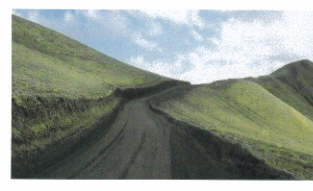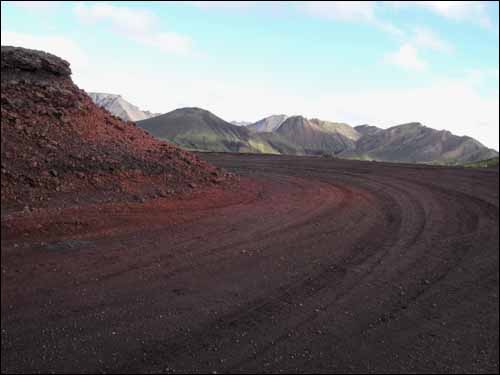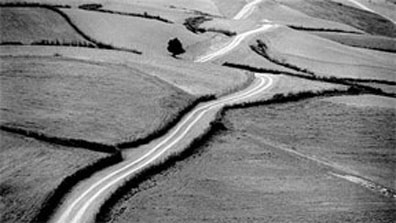Commissioned for a 2011 collection in French devoted to the work of Marylène Negro. My friend Nicole Brenez, who engineered this commission and who translated this piece into French, added a couple of footnotes that I’ve adapted and appropriated here. — J.R.

“I don’t believe in a cinema of literary narrative,” Abbas Kiarostami says in Around Five (2005), “but I don’t believe that cinema can exist without telling a story.” He elucidates this paradox by arguing that viewers consciously or unconsciously impose their own narratives, even on still photographs. And indeed, Roads of Kiarostami [see illustration below], a 32-minute film which Kiarostami also made in 2005, largely consists of imposing his own narratives on his own black-and-white photographs, all of which show roads passing through landscapes. The imposed narratives in this case consist of zooming in and out of or panning across these photographs, which are initially connected to one another by lap dissolves, and then of Kiarostami speaking in voiceover about how and why these photographs came to be taken.
To contemplate roads passing through seemingly uninhabited landscapes — which is what Kiarostami mainly does, and is what Marylène Negro does in her 22-minute film Seeland, also made in 2005 — is fundamentally to ask two different questions: what is nature with and without mankind, and what is narrative? In some respects, these might be two versions of the same question, because roads are the interventions of mankind in a wilderness, and narratives are interventions in another kind of wilderness known as nonnarrative. Roads are pathways that imply itineraries, and to drive through a landscape automatically means not only to tell a story but also to impose one. But, in a film, deciding how to make one road follow another road, how to make one landscape follow another landscape, and, more basically, how to make one image follow another image is not necessarily the same thing as telling a story. And Seeland, more precisely, can be viewed as something that exists somewhere in between telling a story and asking a question — a question pertaining to both landscapes and narratives.
Near the end of his last major critical essay, “Montage,” written with Jean Narboni and Sylvie Pierre (in Cahiers de Cinéma no. 210, mars 1969), Jacques Rivette wrote about “a purely formal suspense: what is the shot going to be? And not: what is going to be in the shot?” This is the formal suspense created in Seeland by the lap dissolves between approximately 100 photographs of roads bisecting landscapes. When one landscape is perpetually overtaking another, any notion of stasis that we might associate with the separate still photographs becomes an illusion, and the question pertaining to both landscapes and narratives is, how do we get from one landscape and photograph to the next? Sometimes they appear to be arranged in a logical sequence, but if they are, the logic of that sequence keeps changing, and even what we define as a road is frequently in fluctuation. Is the story being told the filmmaker’s or the viewer’s? Is it the narrative of an artist ordering and mixing her images, or the narrative of a particular sequential journey taken by her, by us, or by both? Or is it a narrative at all?
Seeland’s soundtrack asks a question of its own — “Are you lonesome tonight?” — an American narrative question which juggles presence and absence as insistently as the images do. This Elvis Presley classic even contradicts its own melancholy by ending in collective laughter. Negro has told me that she chose the song because it represented for her the “American Western spirit” that she felt while driving through Iceland and photographing its desert landscapes, listening to the car radio, and it’s worth adding that she isn’t the only filmmaker to have perceived this particular spirit in the song. The late Edward Yang used the same recording and lyrics, as misperceived by Taiwanese teenagers (2), for both the theme song and title of his 1991 masterpiece, A Brighter Summer Day, to articulate the primary, formative narrative of its major characters — an American legacy recalling a line of dialogue from Wenders’ Kings of the Road (1976): “The Yanks have colonized our unconscious.” Seeland, a “roadmovie,” seeks to decolonize and denarrativize our landscapes, conscious and otherwise.
End Notes
1. Cahiers du Cinéma n° 210, mars 1969, p. 34; see also the essay “Montage” at http://www.dvdbeaver.com/rivette/ok/montage.html
2. Here are the lyrics by Roy Turk and Lou Handman: “Are you lonesome tonight,
Do you miss me tonight?
Are you sorry we drifted apart?
Does your memory stray to a brighter sunny day
When I kissed you and called you sweetheart?” (altered by the characters in A Brighter Summer Day)






